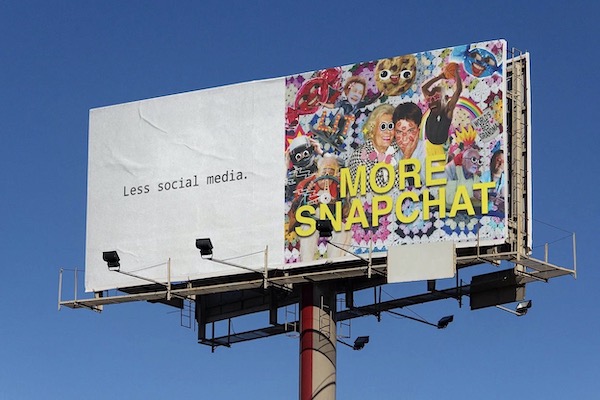Published on the 18/09/2024 | Written by Heather Wright

But will it fly with the youth market?…
Snapchat is heralding a ‘major milestone’ in New Zealand, having topped 1.5 million monthly active users, and is gearing up to snap up more of the local digital advertising market.
The platform, which also has more than eight million users in Australia according to figures it released last year, has just hired its first sales member in New Zealand, with Tama Sefuiva joining to spearhead advertising sales.
“I can’t even think of a time where I have once engaged with advertising.”
Sefuiva, Snap New Zealand senior client partner, says the growing digital market presents an ‘exciting opportunity’ for Snapchat.
Globally the company has signalled its intention to expand and diversify its underperforming advertising business as it fights for advertising revenue alongside Meta’s Instagram and TikTok.
Earlier this month Snap chief executive Evan Spiegel acknowledged the company’s advertising business was growing more slowly that its competitors, dragging down share price performance.
Locally, the company believes it has a captive audience for the advertising business. It says it is now reaching nearly 95 percent of Kiwis aged 13 to 24, and 75 percent of people aged 13 to 34. Fifty percent of its monthly active users in New Zealand are 25 or older.
So how exactly are the ‘youth’ market using Snapchat? And are they really embracing the the augmented reality and providing that significant opportunity for brands?
Fergus McCall, iStart’s web publisher and third year University engineering student, is, like his friends, a Snapchat user.
He falls into the 13-24 year age bracket, and, yup, just as Snap says, he’s a frequent Snapchatter.
“I’ll use Snapchat every day, multiple times, almost as a substitute for texting.”
With his flat group chat and other group chats there, most of the usage is for responding and sending message.
Snap has been pushing the ‘authentic connections’ angle.
The company, which launched in 2011, has eschewed the ‘social media’ tag, with the company’s marketing officer telling Marketing Week earlier this year that social media was alienating many, rather than providing connections, and Snapchat wanted to set itself apart as ‘the antidote’. The company has been pushing a ‘Less social media. More Snapchat’ campaign globally.
“Unlike traditional social media platforms, Snapchat prioritises real-time communication and authentic sharing among close friends and family,” Snap said this week in announcing its Kiwi figures and new appointment.
McCall says alongside the messaging, he also checks out other people’s stories – quick videos or photos friends post – and ‘occasionally’ checks Snap Maps, which allows you to see the locations of friends, and it’s proved to be a hot favourite for many, with Meta currently testing its own version for Instagram.
“I would use Snap Maps to have a look what people are doing – mostly if I’m trying to get in contact with them – although it’s hard not to see what other people are doing while on there,” McCall says. It’s handy when you’re trying to make plans or communicate with people and an easy way to see what’s going on on a Saturday night or who might be up the mountain skiing near you.
“Overall, it’s a pretty useful and fun tool, but it can be a bit creepy to think people can see where you are all the time, hence why I only have mine on for select people.”
But is McCall using Snapchat in the way Snap says so many are – to interact with brands and buy products.
Well, no. And he says his friends aren’t either.
While Snapchat says over 55 percent of Kiwi Snapchatters are engaging with augmented reality (AR) lenses daily, McCall says he doesn’t see the lenses and filters used apart from people using them ‘for a laugh’.
“I never see them being used seriously.”
Globally the company, which has been a frontrunner in its AR offerings, claims more than 300 million Snapchatters are engaging with AR each day and its betting on the technology to help attract both new users and advertisers to the platform.
At its Snap Partner Summit this week, it continued the push, announcing a partnership with OpenAI and a new GenAI suite in Lens Studio to offer advanced tools like body morphing and animation blending for AR creators. An Easy Lens tool makes it possible to build Lenses in a matter of minutes via a chat interface. (The company also introduced its fifth generation of standalone glasses, the AR Spectacles, at the event.)
Snap is pushing Snapchat as a digital ad platform, with Ajit Mohan, Snap APAC president, saying the company sees ‘incredible potential’ for Kiwi (and Australian) brands to build deeper engagement with hard-to-reach local and global audiences.
McCall has a word of warning, saying advertising on Snapchat goes ‘very much ignored’ by him and his friends.
“I can’t even think of a time where I have once engaged with it. My friends are in the same boat. Because the only ads you do see are between stories, you can quickly skip right past them and barely budge a thought to them.”
Globally though, advertising on Snapchat is apparently winning some fans. Monday Haircare by Zuru says its partnership with Snapchat has proven beneficial.
“By tapping into their world of authentic, user-generated content alongside our brand messaging, we saw a surge in both visibility and engagement,” Josh Nightingale, Zuru paid media lead, says. “Snapchat proved to be the key to reaching this elusive demographic.”
McCall is not biting.
“Snapchat is good because you don’t get all the ads that you get on other social media like Instagram or Facebook.
“While there is a bit of it, it’s nothing like those two and it should be kept that way. It should remain primarily as a means of communication, rather than a platform to be engaging with business.”
For McCall and Snapchatting peers though, the future might be more advertising heavy, with Snap saying it is revamping the strategy for its advertising and launching new ad placements, powered by machine learning and automation.



























